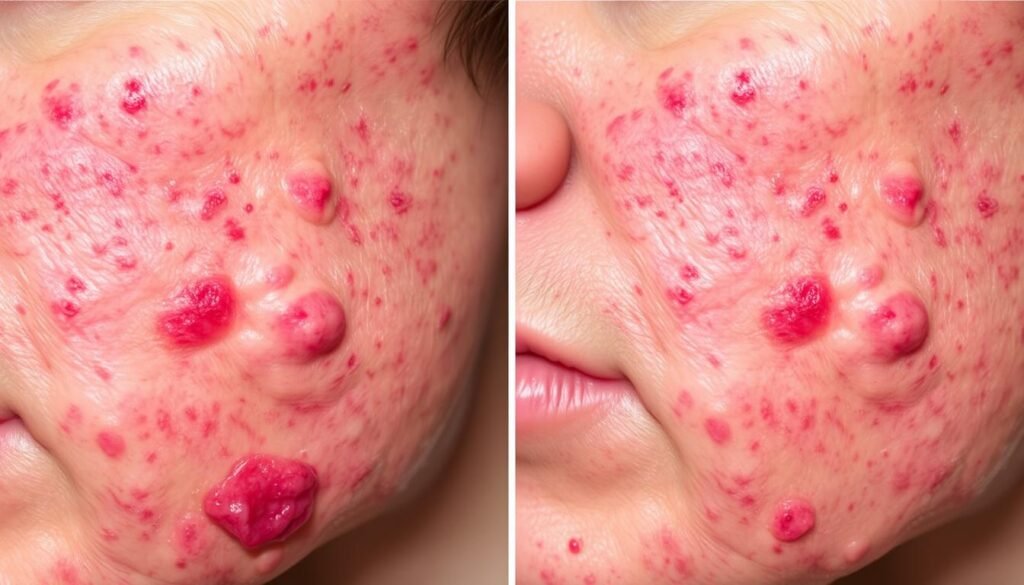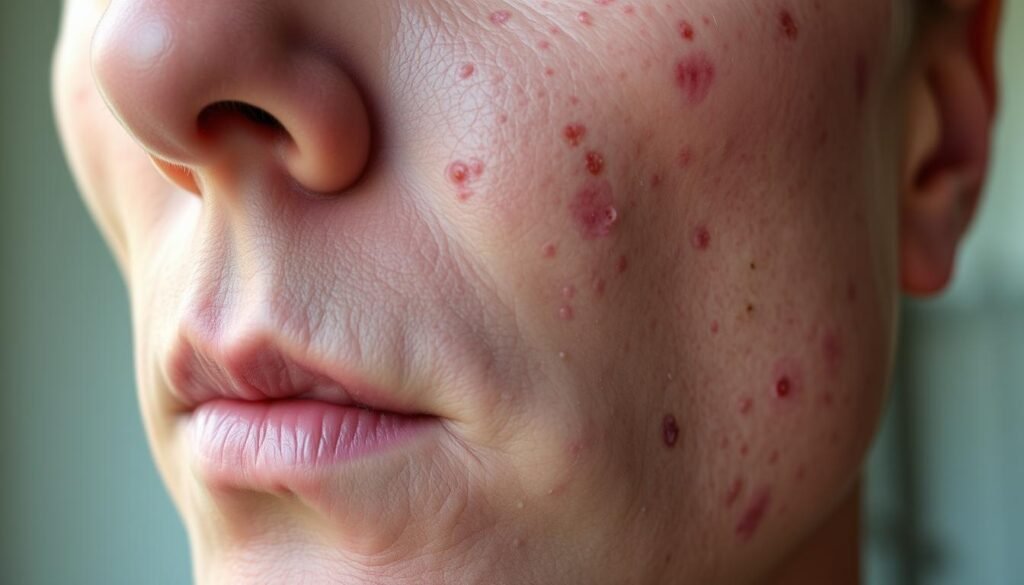About 1-2% of people with acne suffer from acne conglobata, an extreme form. This condition involves many inflamed nodules beneath the skin. It causes not just physical pain but also emotional distress. Severe acne conglobata leads to scarring, especially on the neck, chest, arms, and buttocks. It’s crucial to get professional help quickly. This can lessen the outbreaks and reduce scarring. Here, you’ll see real photos of acne conglobata. These images show the condition’s impact and the path to healing.
Key Takeaways
- Acne conglobata occurs in about 1-2% of acne sufferers, making it one of the most severe forms.
- This form of acne is marked by multiple inflamed nodules that can cause significant scarring.
- Timely professional treatment is crucial for minimizing the severity and risk of scarring.
- Real-life photos can help illustrate the emotional and physical challenges faced by those with acne conglobata.
- Awareness and understanding of this condition can promote compassion and support for affected individuals.
Understanding Acne Conglobata
Acne conglobata is a severe type of inflammatory acne. It is known for painful, connected lumps under the skin. This skin issue mainly hits men in their 20s and 30s. It’s less common but more distressing than other acne types, like acne vulgaris.
Those dealing with it face both physical pain and emotional challenges. It can hurt and make people feel bad about their looks.
What is Acne Conglobata?
Acne conglobata is not your usual acne. It’s a rare kind of nodulocystic acne. Here, nodules merge, creating pus-filled areas beneath the skin. It can show up on the back, chest, neck, or arms. Unlike other acne, it often leads to wide scarring and skin color changes.
Symptoms and Characteristics
The signs of acne conglobata include:
- Painful lumps: These can hurt when touched and vary in size.
- Abscess formation: Pus piles up, forming big, sore cysts.
- Discharge: Broken nodules may let out stinky substances.
- Emotional distress: The look and pain of this acne can hit hard emotionally.
This acne type is more severe than acne vulgaris, which is more common and milder. Acne conglobata needs a doctor’s look and special care.
To wrap it up, knowing acne conglobata’s signs is key to quick recognition. If you think you have it, a dermatologist can help. They’ll suggest treatments that work for you.
The Severity of Acne Conglobata
Acne Conglobata is one of the toughest types of severe acne. People with this condition face a lot of physical pain and mental stress. It’s important to know the different types of severe acne to fully understand how complex this condition is.
Different Forms of Severe Acne
Three major types of severe acne are severe cystic acne, nodular acne, and acne conglobata. They all have their own signs.
- Severe cystic acne: It has deep, painful cysts and can leave scars.
- Nodular acne: This type includes hard, painful lumps under the skin leading to a lot of redness.
- Acne conglobata: This is known for clusters of blackheads, inflamed skin, and many sore lumps causing a lot of scars.
The Impact on Quality of Life
Those who have acne conglobata face big emotional and mental issues. The main problems it causes include:
- Increased social anxiety from worrying about what others think.
- Lowered self-esteem, as ongoing acne affects both personal and work relationships.
- A feeling of being alone because others might not understand their skin problems.
It’s very important to get help for acne conglobata early. Treatments like oral retinoids and systemic steroids can help a lot. They improve how the skin looks and make life better for those with the condition.
Acne Conglobata Photos – See Real Cases
Looking at acne images helps us understand acne conglobata better. These real-life photos show what people go through. They reveal the tough side of severe acne and the positive changes from treatments.
Real-Life Experiences
People dealing with acne conglobata often share their stories in photos. These dermatology photos show the hard times they face. They talk about their struggle and the support they need, highlighting their bravery.
Before and After Treatment Images
Before and after photos show the journey of healing. They highlight how acne conglobata treatment works. This offers hope to others fighting acne. For more on treatments, check out this helpful article.
How Does Acne Conglobata Develop?
Acne conglobata’s onset is influenced by genetics, hormone changes, and certain medications. Knowing these can guide people to get the right help early.
Causes and Risk Factors
This condition mainly hits young males, especially in teens and early 20s. Key risk factors include:
- Being assigned male at birth
- Teenage years or early 20s
- Use of anabolic steroids
- Presence of other follicular occlusion conditions, such as hidradenitis suppurativa
Athletes face a higher risk due to anabolic steroids. It’s key to spot and handle these causes. For more info, check out this page.
The Role of Hormones and Genetics
Hormone swings are big in starting this acne. Teens see a spike in androgens, which makes the skin oilier. Family history also ups the risk. Knowing these factors helps in tackling acne conglobata early.

Acne Conglobata vs. Other Types of Acne
Acne conglobata is often compared to severe cystic acne and nodular acne because they all are inflammatory. It’s important to know the differences. This helps in picking the right treatment.
Comparison with Severe Cystic Acne
Severe cystic acne creates big, painful bumps full of pus. It can cause deep scars, similar to acne conglobata. While cystic acne shows up as single sores, acne conglobata appears as linked nodules, seriously impacting the skin.
Both conditions often need special treatments. Over-the-counter options usually don’t work well. Going to a dermatologist is key for effective management of these tough skin issues.
Nodular Acne and Acne Vulgaris
Nodular acne forms large, red nodules that are hard to treat. It, like severe cystic acne, might scar. Acne vulgaris is generally less severe. It includes common forms like blackheads and smaller, less red sores.
While nodular acne requires more aggressive treatment, those facing acne vulgaris might get by with simpler skincare and store-bought products.
| Type of Acne | Characteristics | Treatment Approach |
|---|---|---|
| Acne Conglobata | Numerous interconnected nodules, painful, severe scarring | Prescription medication, specialized dermatological treatment |
| Severe Cystic Acne | Painful cysts filled with pus, leads to potential scarring | Prescription medication, dermatologist intervention |
| Nodular Acne | Large inflamed nodules, can lead to scarring | Dermatologist-recommended treatments |
| Acne Vulgaris | Includes blackheads and small inflamed lesions, milder symptoms | Over-the-counter treatments, basic skincare |
For more details on different acne forms and how to handle them, check out this detailed guide.
Diagnosis of Acne Conglobata
Diagnosing acne conglobata needs a thorough method by experts. Specialized exams help find its unique signs. This tough acne type gets checked by looking at symptoms, exam results, and medical history. Knowing it well leads to better treatment results.
Professional Evaluation
A dermatologist checks many things about this acne. They look for abscesses under the skin and check the face, back, and chest. Sometimes they take samples to find the best treatment. Knowing the acne’s causes, like hormones and genetics, helps in diagnosing it right.
Importance of Dermatologist Consultation
Seeing a dermatologist for severe acne is crucial. They can make a custom treatment plan that might include medicines like isotretinoin. Getting help early can lower scarring risks and make your skin healthier. If you have acne conglobata symptoms, go to a pro for the best care.

Treatment Options for Acne Conglobata
Acne conglobata treatment needs a careful mix of methods. It combines topical and systemic treatments. This is because the skin condition is severe and requires special care. Knowing what treatments are available is key for those looking to improve their skin.
Topical Treatments and Medications
Topical methods are vital in treating acne conglobata. For instance, adapalene in products like Differin helps stop acne before it starts and lowers swelling. Topical antibiotics tackle the bacteria that lead to big breakouts. However, these might not be enough for everyone.
Systemic Therapies and Their Effectiveness
For tough cases, systemic antibiotics are often needed. These antibiotics are usually taken for around three months to work best. When symptoms are really bad, isotretinoin can make a big difference. It’s strong and fights the deep problems causing serious acne. Studies have shown isotretinoin to be very effective, especially when other treatments don’t work.
Dealing with Acne Scarring
Acne scarring is often a result of severe acne. This is especially true for acne conglobata. Knowing the types of scars is key. This knowledge allows for better decisions on treatment and prevention.
Understanding Scarring Types
Different types of acne scars include:
- Ice pick scars: The most common type, accounting for 60–70% of cases.
- Rolling scars: These make the skin look wavy.
- Boxcar scars: These have sharp edges and are quite noticeable.
- Hypertrophic or keloid scars: Raised scars that can grow beyond the wound.
Those with moderate to severe acne often face these scars. Smoking can also increase the risk. Changing your lifestyle is a key part of preventing these scars.
Prevention and Treatment of Scars
Stopping scars starts with prevention. Treating acne early helps lessen its impact. Not picking at your skin also reduces scar risks. Also, knowing that post-inflammatory hyperpigmentation affects darker skin more helps tailor treatment.
There are many ways to treat existing scars. Options include:
- Dermal fillers: They fill in depressed scars.
- Laser therapy: It encourages new skin growth.
- Surgical treatments: These methods, like punch excision and subcision, remove or release scar tissue.
- Skin needling and dermabrasion: They improve skin texture by removing the top layer.
For insight into treatments, real-life success stories and before-and-after photos can be very helpful. Learn about various approaches through these real-life experiences. Also, debunking acne myths is crucial for effective care. Find out how by reading here.

Raising Awareness About Acne Conglobata
Acne conglobata is not well-known, making it important to spread the word. Social media helps a lot with this. It lets people share their stories and how they deal with acne. This sharing brings folks together, offering community support.
By talking about their experiences, people can fight off the myths and stigma about acne. Everyone feels supported and understood in these online spaces.
Social Media and Community Support
Social networks give people the platform to speak out. Many feel ashamed or blame themselves for their acne. But honest talks on these platforms show that acne has many causes, like genes or hormones.
These discussions help show the emotional impact acne has. They remind us that nobody is facing this alone.
Breaking the Stigma Surrounding Acne
Acne still faces a lot of stigma. Media often shows only perfect skin, making those with acne feel left out. Seeing real skin types in ads and billboards is changing that. It’s helping to challenge the stigma.
Ads that show true empathy and understanding matter. They make a space where everyone feels accepted. They show those with acne conglobata that they are not alone.
Conclusion
Understanding acne conglobata is crucial for affected individuals. Through photos and stories, people can learn about different treatments. Options include systemic antibiotics and ozone therapy, which have been effective.
Ozone therapy, for instance, has helped reduce pain and lesions. This shows great potential for improving lives.
Getting help from a dermatologist is key for dealing with acne conglobata. They provide support and can spot unusual symptoms early. This leads to better results. Studies highlight the importance of personalized treatments.
The fight against severe acne includes both physical and emotional healing. With awareness and support from the community, people can find the right treatment. This helps them accept their skin confidently.